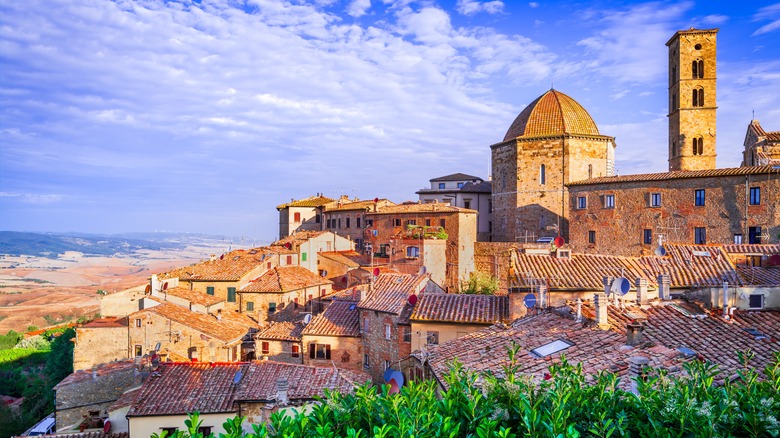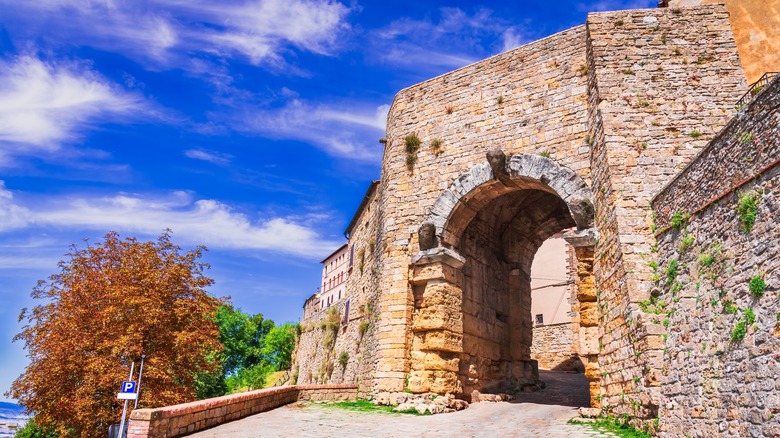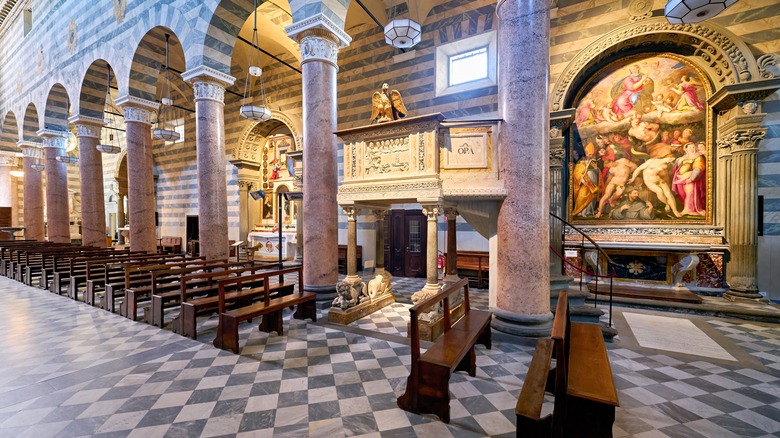Rick Steves Says This Is The Most Underrated Hill Town In Italy
There are hill towns aplenty in the Italian countryside, from Cortona to Montepulciano to San Gimignano. The wonderful old buildings clustered together at the top of a peak, overlooking vast swathes of land (and other hill towns), are a sight to behold. You may have already been to the places we mentioned; however, if you're looking for a great spot that isn't thronged with tourists who have the same idea, travel pro Rick Steves, who always has great travel tips, has a suggestion for you.
On his website, Steves suggests his favorite hill town, Volterra, which is about a 2-hour drive from Florence. It is "perhaps Italy's most underrated hill town," he says. "With both rustic vitality and surprising depth, its out-of-the-way location keeps it from being trampled by visitors."
Volterra has a long history, with Etruscan structures from the 4th century B.C. and an ancient Roman amphitheater and baths. Later buildings include the gorgeous Palazzo dei Priori or city hall from the 12th century C.E., with a special measuring tool in the walls. This isn't a town with a lot of wild nightlife, but if a beautiful spot overlooking the Tuscan countryside full of history and charming streets to explore is what you're looking for, you're going to love Volterra.
Volterra: Etruscan history, shopping, city hall, and the duomo
Volterra's history goes back to the time of the Etruscans, the early inhabitants whose culture flourished in the 6th century B.C. In the 4th century B.C., the Porta all'Arco (above), or Etruscan arch, was built. Steves recommends following its connecting street, the Via Porta all'Arco, full of lovely craft shops with products in bronze and alabaster. To understand the culture, he also suggests visiting the Museo Etrusco Guarnacci (Etruscan Museum), with a collection including funerary urns of alabaster and tufa, and the "urna deli sposi" (urn of the spouses) with an older couple on it. You'll also find a helmet from the Tomba del Guerruccia with its impressive crest.
Palazzo dei Priori, created in 1208, is the oldest civic building in the region, with lions on the side and stunning carvings. One carving is a stone "canna," which was a unit of measurement local to the area. The interior boasts a beautiful 14th-century fresco by Iacopo di Cione Orcagna. Climb the bell tower for a great view.
Nearby is the Cathedral of Volterra, with its Romanesque-Posan facade and its duomo, consecrated in 1120. Inside you'll see incredible art and architecture with striped and checked marble on the walls and floors (below). Make sure to bring a scarf, the Swiss army knife of clothing, to cover your shoulders inside the church. It's also worth checking out the Museum of Alabaster, telling the story of the material that brought wealth to Volterra.
A gorgeous palazzo, ancient architecture, and an evening tradition
Steves says of Volterra, "Embracing the past (along with all that Tuscan sunshine), Volterra offers the best sightseeing of all of Italy's small hill towns," and there is far more to see. One spot he recommends is the Palazzo Viti, which is privately owned. He explains, "Drop by and you're likely to find Signora Viti herself selling admission tickets; behind the ropes you'll see intimate family photos. Your visit ends in the cellar with a short wine tasting." Inside you'll find 12 rooms with art from between 1400 and 1900 C.E. decorating the elaborate rooms full of intricate furnishings and alabaster accents.
There is an ancient Roman amphitheater, which, in turn, provided stone for another project. Steves says, "Around the third century AD, the town began to use the theater stones to build fancy baths instead. You can see the scant remains of the baths behind the theater, including the little round sauna in the far corner with brick supports that raised the heated floor."
Finally, the expert shares, Volterra is pretty quiet in the evening, and the "passeggiata" is a great way to communicate with the locals. Volterra is a quieter spot than others in the region, but Steves says we should slow down "and savor the delights of the region — there are plenty in my favorite Tuscan hill town."


